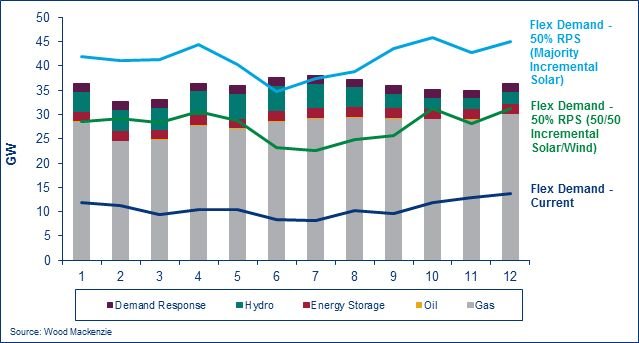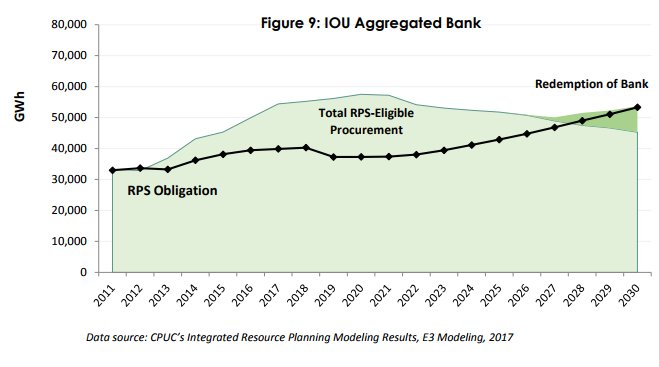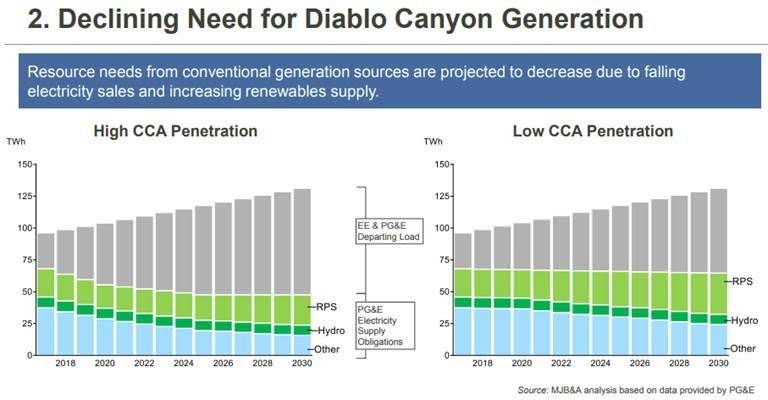As 2017 comes to an end, California can boast that it's making substantial progress toward reaching its ambitious renewable energy goals, which has renewed calls for the state to pass a 100 percent clean electricity target in 2018.
The California Public Utilities Commission recently released its annual renewables portfolio standard report showing that large investor-owned utilities have already executed the renewable electricity contracts necessary to exceed their 33 percent RPS requirement for 2020 -- and are on track to meet the 2030 RPS requirement of 50 percent renewables a full 10 years early.
Building on this momentum, Governor Jerry Brown recently suggested that the state could achieve a 100 percent renewables energy mix before mid-century.
“We will be at 50 percent by the more restricted measures of renewable energy -- that's basically solar, geothermal, wind and some biofuel -- probably in 2025,” he said, speaking at The New York Times’ ClimateTECH conference in San Francisco last month. Reaching “100 percent in 2040 is not out of the question at all.”
But is that target truly within reach?
"California’s energy policies are like driving a car with no seatbelt"
Setting aside the debate on whether or not 100 percent renewables is the optimal way to decarbonize the grid, there a number of very real challenges tied to executing on that goal that are worth addressing. For one thing, California’s investor-owned utilities may not be as close to their renewable energy goals as it may seem. Also, as Governor Brown pointed out in his talk, hitting 100 percent renewables hinges on two big unknowns: “It’ll depend on storage. It'll depend on a regional grid,” he said.
Energy storage and regionalization are indeed major question marks. Without advancements on both fronts, California’s aspiration to achieve 100 percent renewable electricity could remain a pipe dream.
If the renewable energy transition isn’t managed well, it could create a disaster scenario, according to Gary Ackerman, executive director of the Western Power Trading Forum, a broad-based membership organization dedicated to encouraging competition in Western states' electric markets.
“The ability to balance the grid, which is a moment-by-moment function of the grid operator, becomes more challenging as you add more renewable energy,” he said. “It’s undeniable you have to provide a certain frequency within a well-defined bandwidth. When renewable energy comes offline, hence the definition of a variable resource, it presents more challenges to people in the control center. “
There can be up to a 13,000-megawatt ramp in demand in California in the evenings, as solar generation falls off the system and people power up their homes after work, Ackerman pointed out. “You just need one transmission line to trip or generation station to go offline while making that ramp and everything becomes super-critical.”
“You might not see renewables as an issue until then, because people will say the lights haven’t gone out,” he added. “But that’s like saying, ‘I didn’t wear a seatbelt and I didn’t get in an accident.’ California’s energy policies are like driving a car with no seatbelt. You’re taking enormous risks that you won’t realize until it’s too late.”
The need for a lot of innovation
Ackerman is not anti-renewables. His organization includes major wind and solar developers including EDF Renewable Energy, Recurrent Energy and NextEra Energy Resources. And he believes that California utilities will be able to reach 50 percent renewables “easily.”
“The real question is [whether] the California ISO can manage a grid like that,” Ackerman said.
Most Californians want the state’s electricity grid to be totally renewable. According to a poll conducted earlier this year by the Public Policy Institute of California, 76 percent of adults and 71 percent of likely voters -- including 81 percent of Democrats and 53 percent of Republicans -- approve of a 100 percent renewable energy requirement. The question facing policymakers, advocates and industry leaders now is how to fit all of the pieces together to make 100 percent possible.
Natural-gas peaker plants have played a key role to date in enabling CAISO to manage ever-higher levels of intermittent renewable energy generation. Energy storage has and will continue to play a pivotal role as well. But the technology is not where it needs to be to serve as the backbone of the grid, as Brown alluded to.
“California can integrate renewable energy [today] without real challenges because the grid is overbuilt,” said Wade Schauer, research director for the Americas power and renewables market at Wood Mackenzie, referring to the natural-gas plants that are already on the grid. “To get to 100 percent, you have to replace that one for one with storage. Not just any storage, multi-day storage -- and there aren’t batteries out there doing that now. There’s going to have to be a lot of innovation, and that’s not going to be cheap.”
Anything can happen in 20 years, Schauer added -- who knows what technology will be available in 2040? However, he is certain that if California tries to achieve 100 percent renewables too quickly, “it’s going to be very painful.”
Just getting to 50 percent renewables in California is going to require some major investments. According to a Wood Mackenzie analysis, under a 50 percent RPS with solar making up the majority of incremental additions (43 gigawatts of incremental solar and 2 gigawatts of incremental wind), an additional 10 gigawatts of flexible capacity -- a combination of thermal generators, hydropower, demand response and energy storage resources -- would need to be procured by 2030 in order to meet the system’s ramping needs during the shoulder months.
Even taking a more balanced approach between solar and wind would increase flexible capacity needs significantly in the longer term.

Meanwhile, the grid will have less gas to rely on, because California’s environmental regulations make natural-gas peakers an unattractive option in the long run. Wood Mackenzie projects the state’s once-through cooling requirements for gas plants will reduce California’s effective flexible capacity by nearly 9 gigawatts before 2030. With renewable energy curtailment increasing, and with the ongoing need to maintain reliability and affordability for customers, the role of grid edge and energy storage technologies will be critical.
And according to some, a regional grid may be essential.
Brown pledges to pass regional grid legislation in 2018
California is already partnered with eight Western states in the Energy Imbalance Market (EIM), where energy is balanced in real time. An integrated Western regional grid would stretch from western Canada to Baja California in Mexico, covering 14 U.S. states and a total of 38 balancing area authorities. And, in contrast to the EIM, it would balance energy supply and demand in a day-ahead market that matches electricity to the projected load over 24 hours. By coordinating power flows across a larger footprint, an integrated regional grid would help to ensure that emissions-free energy is being dispatched efficiently.
“A regional grid is important, because right now with our 30 percent renewable energy [mix], there are many hours on moderately warm days with bright sun where we're dumping huge amounts of electricity, because we have nowhere to use it,” said Brown. “When we have a bunch of electric cars, we can charge the cars. When we have batteries, we can charge the batteries. But we don't have that.”
“Renewable energy is not going to really make sense beyond 30 or 40 percent without a regional grid,” he said.
The political challenges tied to reaching 100 percent renewables in California, which include regionalization, are arguably going to be more difficult to overcome than the technical ones.
California lawmakers tried passing a mandate to create a 100 percent renewable grid by 2045 and attempted to remake the state’s grid into a regional system. But those efforts failed, largely because labor unions were worried about losing local jobs in California as the system expands, and because environmental groups were concerned that a regional grid would cause California to lose control of its energy mix.
Brown acknowledged there are a lot of politics involved in the regional grid debate. “That kind of vulgar politics, which I'm so attracted to,” he joked.
“We will get it done,” he added, with sincerity. “There are just…a couple of deals that need to be made.”
The politics are "impossible"
There’s a lot of tension around giving up control of California’s grid through CAISO, and sharing the decision-making power with other regional players, like the Rocky Mountain states utility PacifiCorp. But Brown seemed confident he could allay those concerns.
“The people who sell solar have one view. The utilities have a view. The people in the unions who install [grid technology] have a view. Some of the purists have a view that if we have a regional grid with…coal people, they'll contaminate us. So we have a few things to overcome,” he said. “I'd say that we have a good chance of doing it. If we don't do it this year, I'm sure it'll come through the next year.”
But there’s a problem, said Ackerman. Even if Californians agree to pursue a regional grid, who says other states will want to participate?
“I’m not criticizing Governor Brown. If there’s an adult in the room, he’s it. He knows what he’s talking about. [He] recognizes there is this reliability threat and the best way to try and solve it is to regionalize the California grid,” he said. “The problem is that no one in the rest of the West wants California’s energy, because their energy is already cheap. Plus, they’re not going to integrate with California because of the politics of California.”
“Overcoming the political friction is almost impossible,” Ackerman said.
Near-term wins?
Tony Brunello, president and founder of More Than Smart, a nonprofit that supports greater integration of distributed energy resources, is in favor of a unified grid linking California with other states in the West. But he believes there needs to be greater focus on near-term wins, starting with California, Washington and Oregon coordinating their resource-planning projections to take advantage of cross-border benefits.
“Why are we not spending more time discussing near-term wins with equal passion, like selling California's oversupply of natural-gas electricity generation to Oregon and Washington instead of them building new natural-gas plants facilities,” he said. “Or using Northwest hydropower in California as a flexible resource that can be used when we need it most.”
“In essence, we need to get a few base hits while we also go for the multistate regional grid home run,” Brunello said.
Near-term wins could be key as stakeholders work through other complex challenges tied to a larger expansion. For instance, creating a truly regional grid that’s open to all utilities west of the Rockies will require building a lot of new transmission lines (although not everyone agrees about this), and those projects can take up to 20 years to complete, said Schauer.
Then there’s the issue of other states boosting their renewable energy penetration at the same time as California, he said. If surrounding states continue to add solar because it’s cost-competitive, then the steep evening ramp, known as the duck curve, will hit the entire regional grid.
“Neighboring states are ramping up solar as well over next few years. So California’s ability to lean on those states during over-production hours will go away,” said Schauer. “California won’t be able to sell its surplus solar to Arizona because they also have a surplus problem.”
A regional grid “sounds good on paper, but actually making it happen will be a challenge,” he said, which increases the pressure to deploy advanced energy storage and other grid tech.
The added complexity of community choice aggregation
In the thick of California’s 100 percent renewable electricity debate, there is the rise of community-choice aggregators, or CCAs, where cities or counties ditch their utility to purchase their own energy generation directly from independent suppliers.
Between 2010 and 2015, two CCAs formed serving approximately 135,000 customer accounts statewide. Between 2016 and 2017, CCA formation accelerated and 12 more communities launched or submitted CCA implementation plans. The CPUC estimates that up to 85 percent of California’s retail load could be served by CCAs or direct access providers by 2025.
CCAs add complexity to reaching a 100 percent renewables for a few reasons. First of all, CCAs have been wary of regionalizing the Western grid. Regionalization could result in higher exit fees to form CCAs and longer-term energy contracts between utilities could make CCA energy procurement tricky, among other things.
The rise of CCAs also obscures how much progress investor-owned utilities (IOUs) have made in reaching their renewable energy mandates and makes resource procurement more complex.
The CPUC’s latest RPS report found that Pacific Gas & Electric’s electricity mix is 32.9 percent renewable, Southern California Edison’s is 28.2 percent renewable and San Diego Gas & Electric’s is 43.5 percent renewable. According to Schauer, the IOUs have made so much progress toward their goals because 1) they rushed to take advantage of federal tax credits for solar and wind before those expire; 2) the utilities procured renewables assuming a certain level of retail load that has failed to materialize or that they are no longer responsible for serving; and 3) this has generated a surplus of renewable energy credits (RECs) above RPS requirements for the past several years. Those surplus RECs can be banked for use in future years when there would otherwise be a RPS deficit, he explained. Pacific Gas & Electric has accumulated a REC bank large enough to meet its renewable requirements through 2030 without any new renewable procurement.
Point 2 is where the CCAs come in.

“IOUs are losing customer load to CCAs, but still have all of the renewable energy contracts they procured to serve those customers,” Schauer said. “That load didn’t go away, but now the CCAs will need to either buy the surplus RECs from the IOUs and/or contract with new renewable resources. Meanwhile, the IOUs can claim they are meeting future-year renewable goals that in reality are much lower targets than they once were in absolute terms.”
This point is fleshed out in the CPUC’s RPS report, which states that the three large IOUs are positioned to meet the 50 percent mandate a decade early thanks to “excess procurement” through the REC banking provisions. “The IOUs’ excess procurement is based on the current forecast of bundled electricity load and additional CCA departures will result in increased amounts of excess,” the report states.
Because of that departing load, PG&E projected RPS energy requirements (in terawatt-hours) barely grow from today's levels, even though the RPS requirements increase from 33 percent in 2020 to 50 percent in 2030. Falling electricity sales combined with the increased renewables is squeezing conventional generation out of the system, which is why PG&E decided to close the Diablo Canyon nuclear plant.

While IOUs cope with retirements, CCAs will need to procure additional renewable energy resources to ensure they comply with the RPS. Plus, most California CCAs have their own longer-term goals to reach 100 percent renewables for all customers. The cumulative volume of utility-scale PV driven by CCAs in development or operating is currently 1.2 gigawatts, according to GTM Research.
As this transition takes place, it creates an issue around resource planning.
A recent CPUC report questions the commission’s authority over CCAs, which has “somewhat reduced the most optimal procurement and coordination of resources and utilization,” staff reported. The shift to localized decision-making adds complexity to system-level procurement plans, which could make it harder -- or at least more expensive -- to meet a 100 percent renewable energy target statewide.
To help get all players on the same page, the CPUC recently issued a proposal that, if adopted at the commission's meeting on Jan. 11, 2018, would require CCAs to fully comply with CPUC Resource Adequacy rules before they can start serving customers. The move is designed to ensure sufficient energy generation is under contract, by the appropriate utility, to meet peak demand for the coming year.
“Community choice aggregator participation in the Resource Adequacy program ensures that the community choice aggregator is procuring enough energy for its customers while relieving the customer’s prior utility of that responsibility,” a CPUC release states. “This helps prevent over-procurement or under-procurement and cost-shifting.”
Uncertainty surrounding the expansion of CCAs, regionalization and the pace of energy storage technology development will surely persist into 2018 -- which is Brown’s last year in office. Amid all of this, getting to 100 percent renewables by 2040 is not “out of the question,” as Brown said -- but it raises a lot of them.